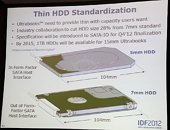Thursday, April 12th 2012

7 mm Won't Cut It, Intel Wants 5 mm-Thick Drives for Ultrabooks
Custodian of the Ultrabook specification, Intel pushed the storage industry to churn out slimmer devices to go with increasingly slimmer Ultrabooks sold by the various partner ODMs in the ecosystem. Even as HDD and SSD makers have only just come up with 7 mm-thick storage devices, Intel has a fresh list of changes it wishes to see with storage devices in the very near future, to be able to make it to the constantly-evolving Ultrabook specification. Intel wants near-future storage devices (SSDs and HDDs) to be no thicker than 5 mm.
Further, it wants to see the standard SATA host interface changed from "around" (out of) form, to "along" (inside) form host interface, which further slims down the drive compartment. These proposals were floated at IDF, Beijing. While coming up with slimmer SSDs was never really a tough task for SSD makers, as SSDs are essentially just millimeter-thick printed circuit boards with millimeter-thick components (controller logic, NAND flash memory, and ancillaries), it posed a huge technical challange to mechanical HDD designers, who have had to slim down key components that work to maintain inertial motion of spinning platters. This new proposal for 5 mm-thick HDDs could pose a newer, tougher desgin challenge.
Source:
VR-Zone
Further, it wants to see the standard SATA host interface changed from "around" (out of) form, to "along" (inside) form host interface, which further slims down the drive compartment. These proposals were floated at IDF, Beijing. While coming up with slimmer SSDs was never really a tough task for SSD makers, as SSDs are essentially just millimeter-thick printed circuit boards with millimeter-thick components (controller logic, NAND flash memory, and ancillaries), it posed a huge technical challange to mechanical HDD designers, who have had to slim down key components that work to maintain inertial motion of spinning platters. This new proposal for 5 mm-thick HDDs could pose a newer, tougher desgin challenge.

43 Comments on 7 mm Won't Cut It, Intel Wants 5 mm-Thick Drives for Ultrabooks
They will most probably get to 5 mm 2.5 inch HDDs but, like you said, performance will suffer. SSDs seem like a better choice going forward.
I wonder whether there is any gain in the above when choosing a smaller, thinner drive vs. a regular (for example 3.5'') one. Obviously there is a direct saving of material and shipping effort for smaller, lighter products. But how about the up-front costs of this down-the-road gain? How much more of resources and energy (X%) have to be expended during development and production of a product that saves Y% resources and energy compared the previous version? Anyone can give a founded opinion? Thanks!
External hds are for back up\storage purposes... haven't meet anyone who carries one around like a thumb drive. Honestly surprised by interest in ultra books..... thought the use of the word ultra alone would've been enough to tank it. Customers ultimately want the portability of a tablet with the power of a desktop. Until we get there ... the ultras actually do have a place.
Even if it is merely tablets with physical keyboards that lock onto it like the Asus transformer.
Considering the higher end models still overheat and have to get a separate laptop cooler- Dell had it right with the Dell Inspiron 9100/XPS Gen1 Chassis Running P4 EE (Gallatin or Prescott) on 965PE Chipset 2 GB PC 3200 DDR and Radeon 9800 256 (R420)
But netbooks on their own make sense from a low cost internet browsing only usage viewpoint.
... But an ultrabook?... really? Two pounds difference for something 30-50% faster with longer battery life, which is more durable, and lasts longer.
So aesthetics is the only thing I can think of as to what would drive the sale of one.
or atleast give us retail 2.5" ocz kilimanjaro ssds!
If anyone thinks an ultrabook is useless/too expensive, then its not for them. Simple as that.
(see presentation slides at end of article)